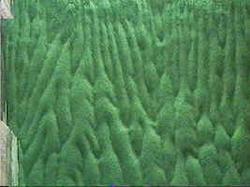Antigravity in a Sandbox

Large objects seem to defy gravity in a shaking box of sand, according to a report in the 16 November PRL. The authors found that with vigorous shaking, heavy objects placed in the sand float to the top, while light objects sink. They propose a partial explanation for the phenomenon but admit to being puzzled by some of their observations. The experiments provide an example of the surprisingly complex behaviors physicists have seen in granular materials, which do not obey standard equations for either fluids or solids.
Sand can “flow” when shaken and conform to the shape of a container, but it’s not a fluid. It can support the weight of an object, but it’s not a solid. In fact, physicists have been unable to come up with a basic set of equations to describe the simplest behaviors of granular materials. They would like to explain granular flows with comprehensive equations like those known for fluids, partly for industrial applications: Granular materials are handled in many industries, including electronics materials, oil and gas (soil dynamics), paper and glass manufacturing, and agriculture. Mixed solids, such as pigments, pharmaceuticals, and processed foods, undergo large amounts of shaking during processing and transport, and the producers would like their products to remain well-mixed. But some physicists simply enjoy working with such seemingly simple systems. “Most of our work involves experiments that a three-year-old could do,” says Troy Shinbrot, of Rutgers University in Piscataway, NJ, “and yet we grown-up scientists can’t explain them.”
One of the many strange phenomena physicists have studied is the “Brazil nut” effect: Shake a can of mixed-size nuts, and the largest ones tend to float to the top. One possible explanation is that the shaking sets up a nut convection, with a narrow band of material continually sinking along the sides of the container, while material away from the edges flows upward. According to this theory, the largest nuts are too wide to fit in the narrow sinking layer along the edges and are trapped on top. But Shinbrot and his Rutgers colleague Fernando Muzzio found a different effect, one that involves density rather than size. They put plastic Easter eggs filled with varying amounts of steel shot on a bed of fine glass powder and shook vigorously, at a range of frequencies around 10 Hz. The heavier eggs floated as expected, but the lightest eggs sunk to the bottom. According to Shinbrot, anyone can observe the effect by filling a jar half-way with salt, placing a steel nut and a screw bottle-cap (or other high- and low-density objects) inside, and shaking vigorously.
Shinbrot and Muzzio propose that the larger inertia of a heavier object allows it to lift smoothly in the air with each shake, so that the surrounding powder can easily slide underneath it and gradually raise it up. A lighter object is more easily jostled by nearby particles, allowing less opportunity for them to seep underneath it. The team ran a computer simulation of a one-dimensional version of their system, and the results qualitatively support their explanation. But Shinbrot concedes that much more work is needed before he can explain the data in detail and compare them with other experiments.
Anthony Rosato, of the New Jersey Institute of Technology in Newark, says the experiments show that “there are a lot of things that we just don’t know” about granular materials. He adds that while observations like these are important, real progress will only come when researchers develop more comprehensive theories that account for a wide variety of granular phenomena.


